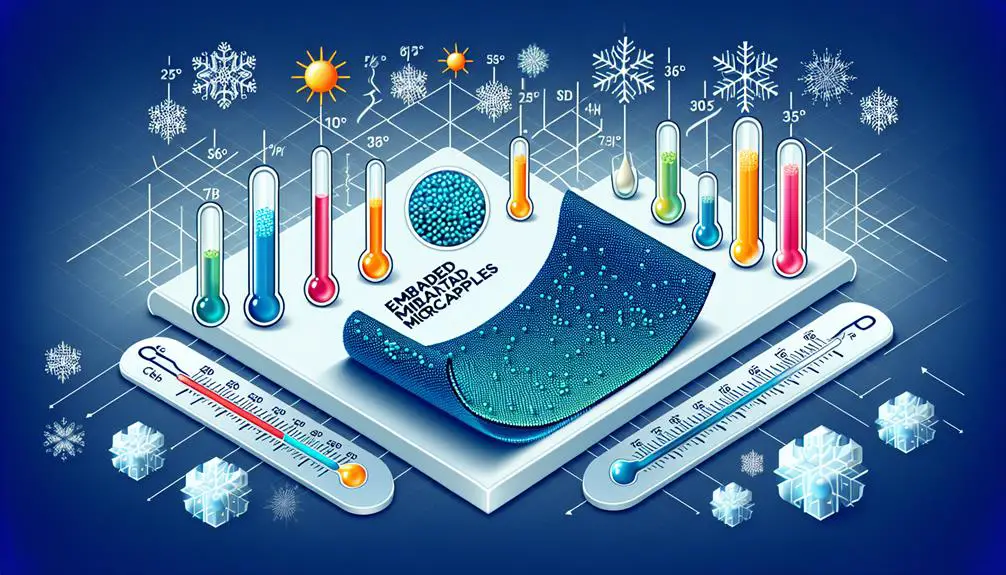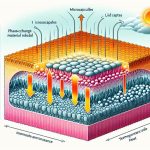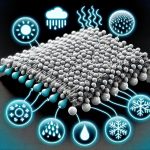Imagine wearing a jacket that keeps you cool when you're hot and warm when you're cold. Phase-change materials (PCMs) make this possible by regulating temperature through their unique ability to absorb and release heat. These smart fabrics aren't just about comfort; they promise enhanced performance in various fields, from sportswear to medical textiles. But how exactly do these materials work, and what makes them so effective? Before we explore their fascinating applications and potential, it's vital to understand the science behind PCMs and their integration into fabrics.
Table of Contents
Key Takeaways
- PCMs in smart fabrics regulate temperature by absorbing and releasing heat through phase changes.
- Integration methods include coating, lamination, and embedding PCMs within fibers.
- PCMs enhance thermal comfort in outdoor wear, sports apparel, and medical textiles.
- Organic PCMs offer stability and non-toxic properties, while inorganic PCMs provide higher heat storage.
- Adoption of sustainable manufacturing and recycling processes reduces environmental impact.
Understanding Phase-Change Materials
Phase-change materials (PCMs) are substances that absorb and release thermal energy during the process of melting and freezing. Understanding the material properties of PCMs is essential for mastering their application in fabric technology. These materials undergo a phase change at specific temperatures, allowing them to maintain or regulate temperature by absorbing excess heat or releasing stored thermal energy. This unique characteristic makes them groundbreaking in fabric technology, providing active thermal management.
You'll find that the key material properties of PCMs include high latent heat capacity, stability over many cycles, and non-toxic behavior. These properties guarantee that PCMs can be integrated effectively into fabrics without compromising safety or performance. For instance, incorporating microencapsulated PCMs into fibers allows the fabric to dynamically respond to temperature changes, providing personalized comfort.
In fabric technology, PCMs can be embedded into textiles through various methods like coating, lamination, or fiber integration. This integration enables fabrics to adapt to environmental conditions, making them ideal for outdoor wear, sports apparel, and even medical textiles. By mastering the interplay between PCMs and fabric technology, you can create advanced textiles that offer superior thermal regulation and comfort.
How PCMs Work
To grasp how PCMs work, you need to understand their thermal energy storage mechanism. They absorb and release heat to regulate temperature, ensuring you stay comfortable.
PCMs change their state based on the surrounding temperature, seamlessly maintaining an ideal climate.
Thermal Energy Storage Mechanism
When integrated into fabrics, PCMs store and release thermal energy by changing their state from solid to liquid and back. This transformation enables effective heat absorption and energy storage. When the temperature around the fabric increases, the PCM absorbs excess heat, melting from a solid to a liquid state. This process is known as endothermic reaction, and it allows the fabric to store energy.
Here's how it works:
| Phase | State Change | Process | Thermal Effect |
|---|---|---|---|
| Initial State | Solid | Heat Absorption | Energy Storage |
| Temperature Up | Solid to Liquid | Melting | Cooling Effect |
| Temperature Down | Liquid to Solid | Freezing | Heat Release |
| Final State | Solid | Heat Discharge | Stable Temperature |
When the surrounding temperature drops, the PCM releases the stored energy as it solidifies. This exothermic reaction guarantees that the fabric can provide warmth by discharging the previously absorbed heat. The cyclical nature of this mechanism makes PCMs highly effective in maintaining thermal comfort. Understanding these principles allows you to admire the sophisticated design behind smart fabrics, which seamlessly integrate cutting-edge materials science to enhance everyday wear.
Temperature Regulation Process
In smart fabrics, PCMs work by actively regulating temperature through their ability to absorb and release heat during phase alterations. When you're active and your body heats up, the PCMs in your fabric absorb excess heat, shifting from a solid to a liquid state. This heat absorption creates a cooling effect, preventing you from overheating.
Conversely, when the temperature drops, the PCMs release the stored heat as they solidify, providing warmth to maintain your comfort. These phase-change materials are embedded within the fibers of the fabric, making the temperature regulation process seamless and responsive. You won't even notice the shift happening, but you'll definitely feel the benefits.
The key to their effectiveness lies in their ability to repeatedly cycle through these phase alterations, ensuring consistent thermal management. For those who seek mastery in understanding smart fabrics, it's vital to recognize that the efficiency of PCMs depends on their thermal properties and the specific application.
High-quality PCMs can optimize your comfort across various environmental conditions by balancing heat absorption and release. This cutting-edge technology is revolutionizing the textile industry, offering unparalleled comfort and functionality.
Benefits of Smart Fabrics
You'll be amazed at how smart fabrics can enhance your daily life. They offer superior thermal regulation, keeping you comfortable in any weather.
They can also boost energy efficiency by reducing the need for external heating or cooling. Imagine wearing clothing that adapts to your needs while saving energy—it's a win-win!
Enhanced Thermal Regulation
Smart fabrics offer the remarkable benefit of enhanced thermal regulation, keeping you comfortable in varying temperatures. Imagine being able to maintain improved comfort no matter the season or environment. These innovative materials adapt to your body's needs, absorbing and releasing heat as necessary. When you're cold, they store heat to keep you warm; when you're hot, they release it to cool you down. This dynamic response ensures that you're always at an ideal temperature, enhancing your overall well-being.
What makes these fabrics even more impressive is their sustainable technology. Traditional textiles often rely on synthetic fibers and chemical treatments that can harm the environment. In contrast, smart fabrics utilize phase-change materials that are more eco-friendly and efficient. This sustainable approach not only reduces waste but also offers long-lasting performance, making it a win-win for both you and the planet.
Moreover, the adaptive nature of these fabrics means fewer layers are needed to achieve the same level of comfort, simplifying your wardrobe and reducing the need for excessive clothing.
Embrace the benefits of enhanced thermal regulation with smart fabrics and experience a new level of comfort and sustainability.
Increased Energy Efficiency
Imagine cutting down on your energy bills simply by wearing clothes made from smart fabrics. These advanced textiles use phase-change materials (PCMs) to regulate your body temperature, making your home heating and cooling systems work less. Smart fabrics can absorb, store, and release thermal energy, ensuring you're comfortable in various climates without cranking up the thermostat.
Energy savings don't just help your wallet; they also contribute to a greener planet. By reducing the need for excessive heating and cooling, you're not only saving on utility costs but also decreasing your carbon footprint. This sustainable technology aligns with a growing demand for eco-friendly solutions, making it a win-win for both you and the environment.
Let's break down how smart fabrics contribute to energy efficiency:
| Benefit | Description | Impact |
|---|---|---|
| Temperature Control | Regulates body heat | Reduces reliance on HVAC systems |
| Energy Storage | Absorbs and releases thermal energy | Minimizes temperature fluctuations |
| Eco-Friendly | Sustainable technology | Lowers carbon footprint |
Understanding the benefits of smart fabrics can empower you to make informed choices that contribute to both your comfort and the planet's well-being. Embrace this innovative approach and experience firsthand how cutting-edge textiles can revolutionize your daily life.
Types of Phase-Change Materials
Among the various types of phase-change materials, you'll find organic, inorganic, and eutectic compounds each offering unique thermal management properties. Each type brings distinct PCM properties that can be leveraged for a wide range of PCM applications.
Organic PCMs, usually composed of paraffins or fatty acids, are known for their excellent thermal stability and non-corrosive nature. They melt and solidify repeatedly without significant degradation, making them ideal for long-term use. Organic PCMs are often used in textiles for their reliability and consistent performance.
Inorganic PCMs, typically consisting of salt hydrates, offer a higher latent heat storage capacity compared to their organic counterparts. They're also less expensive but can be corrosive and potentially more prone to supercooling. Despite these challenges, their high thermal conductivity makes them suitable for applications where rapid heat transfer is essential.
Eutectic PCMs are a blend of organic and inorganic materials, designed to combine the best attributes of both. They offer a tailored melting point and balanced performance, making them highly versatile. With a customized thermal response, eutectic PCMs are gaining traction in advanced thermal management solutions.
Understanding these PCM properties allows you to select the right material for a variety of PCM applications, ensuring best possible performance in your smart fabric designs.
Applications in Sportswear
In sportswear, phase-change materials (PCMs) can significantly enhance performance by regulating body temperature during intense physical activities. Imagine you're pushing your limits on a marathon run or sweating it out during a high-intensity workout. PCMs embedded in your gear can absorb excess heat when your body temperature rises, storing it until you cool down. Then, they release this stored heat to maintain ideal comfort levels. This dynamic process not only boosts performance improvement but also guarantees athlete comfort, making every movement more efficient.
Sweat management is another vital benefit of PCMs in sportswear. Traditional fabrics often become saturated and heavy, hindering performance. But with PCMs, moisture is managed more efficiently. They work in harmony with your body's natural cooling mechanisms, enabling better body temperature control. By minimizing sweat accumulation, they keep you dry, reduce chafing, and help avoid overheating, ensuring you stay focused on your goals.
Integrating PCMs into sportswear isn't just a breakthrough in fabric technology; it's a game-changer for athletes striving for excellence. By optimizing both performance and comfort, these intelligent fabrics enable you to train harder, recover faster, and perform at your peak.
Medical Textile Innovations
Medical textile innovations are revolutionizing patient care by integrating advanced materials that promote healing and comfort. Imagine a world where bandages intelligently regulate moisture, or hospital gowns monitor vital signs. These aren't futuristic fantasies but current realities driven by innovative medical textiles.
By leveraging phase-change materials, these smart fabrics adapt to body temperatures, optimizing both wound healing and overall patient comfort.
In the field of healthcare advancements, these textiles are game-changers. For example, pressure garments infused with phase-change materials can manage body temperature, significantly enhancing the recovery process for burn patients. Similarly, smart bandages embedded with sensors can detect infection, alerting healthcare providers promptly and potentially saving lives by enabling early intervention.
Additionally, antimicrobial fabrics are being used to create hospital linens that reduce the risk of infections, a critical concern in clinical settings. These fabrics not only provide a sterile environment but also improve patient outcomes by minimizing complications.
By integrating such advanced solutions, innovative medical textiles are setting new standards in healthcare, ensuring treatments are both effective and comfortable.
You're not just witnessing an evolution in textiles; you're experiencing a paradigm shift in healthcare that prioritizes patient well-being through cutting-edge material science.
Environmental Impact
Smart fabrics are not only transforming industries but also raising important questions about their environmental impact. As someone pursuing expertise, you should consider how sustainable manufacturing and recycling processes play a role in reducing the carbon footprint of these advanced materials. It is crucial to weigh the benefits of smart fabrics against their ecological costs.
One major concern is the carbon footprint associated with producing these fabrics. Traditional manufacturing methods often involve harmful chemicals and substantial energy consumption. Fortunately, eco-friendly alternatives are emerging, focusing on more sustainable manufacturing techniques. These methods aim to lower energy use and minimize waste.
Sustainable Manufacturing | Recycling Processes | Eco-Friendly Alternatives
:——————————|:———————-|:—————————–
Reduces energy consumption | Converts waste to new products | Utilizes biodegradable materials
Minimizes chemical use | Extends life cycle of materials | Reduces environmental harm
Promotes resource efficiency | Decreases landfill waste | Encourages renewable sources
Future of Smart Fabrics
Looking ahead, you'll see smart fabrics evolving to offer even more innovative and practical applications in everyday life. As technology progresses, the integration of wearable tech innovations and smart clothing trends will redefine how we interact with our environment and our wardrobe.
- Sustainability in textiles: Future smart fabrics will prioritize eco-friendly materials and production methods. This means recycling old garments into new smart textiles and reducing environmental footprints.
- Enhanced functionality: You'll witness fabrics capable of self-cleaning, UV protection, and even health monitoring. Imagine clothing that can track your essential signs and alert you to potential health issues.
- Fashion technology: The fusion of fashion and technology will result in garments that are both stylish and functional. Designers will incorporate smart fabrics to create pieces that adapt to temperature changes, ensuring you're comfortable in any climate.
- Interactive clothing: Smart fabrics will enable interactive experiences, such as garments that change color or pattern based on your mood or surroundings. This level of personalization will make your wardrobe truly unique.
Frequently Asked Questions
How Do Phase-Change Materials Affect Fabric Care and Maintenance?
You've got to know that phase-change materials boost fabric durability and reduce maintenance requirements. Follow specific cleaning instructions to maximize longevity benefits, ensuring your smart fabrics stay in peak condition for longer.
Are There Any Safety Concerns With Phase-Change Materials in Clothing?
You should consider potential health risks and guarantee the clothing meets safety regulations. Additionally, think about the environmental impact and proper disposal methods to mitigate any negative effects on the planet.
What Is the Cost Difference Between Regular and Pcm-Enhanced Fabrics?
You'll find the cost difference between regular and PCM-enhanced fabrics significant. However, the durability comparison shows that PCM-enhanced fabrics often last longer, justifying the higher price. Mastery of smart fabric technology comes with understanding these trade-offs.
Can Phase-Change Materials Be Used in Everyday Clothing?
Yes, you can use phase-change materials in everyday clothing. They offer thermal regulation and comfort, ensuring durability while aligning with fashion trends. You'll experience enhanced comfort without sacrificing style or the longevity of your garments.
How Long Do Phase-Change Materials Last in Smart Fabrics?
When it comes to phase-change materials in smart fabrics, they're not a flash in the pan. Their durability and performance can last for years, but environmental impact and usage intensity will influence their longevity.
- What Is the Wet Tie-Dye Technique for Vibrant Colors? - July 13, 2025
- What Is the Dry Tie-Dye Technique and When Should You Use It? - July 13, 2025
- The Difference Between Wet and Dry Tie-Dye Techniques Explained - July 13, 2025







